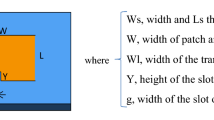Abstract
In this paper, the possibility of different configurations of a novel Koch fractal geometry for the miniaturization and broad banding of a microstrip patch antenna, while maintaining its gain and radiation pattern, is investigated. To achieve the best results, the invasive weed optimization (IWO) algorithm, which is shown to be very robust and adaptive, is used for optimization. The whole design procedure is auto-controlled by linking, the high-frequency structure simulator with MATLAB software. For the first configuration, IWO is used to find the best location of feed point to minimize the return loss, e.g., S 11 (\(\left| {S_{11} } \right| < {-}10\;{\text{dB}}\)) and hence increasing the radiation efficiency of the proposed antenna. \(\left| {S_{11} } \right|\) of about −40 dB was achieved. Next, the proposed fractal with air-filled substrate and a ring slit is presented. The key design parameters such as air gap height, the slot gap width, location of feed point have been optimized using IWO to obtain the best possible bandwidth. Simulation results show a fractional impedance bandwidth of about 40% (2.42–3.59 GHz). This band is used by weather radar and some communication satellites. Gain and radiation pattern of the proposed antenna are acceptable within the frequency bandwidth. A prototype of the antenna is also fabricated and tested. Measured parameters are in good agreement with the simulated results.
























Similar content being viewed by others
References
Coleman C, Rothwell E (2004) Investigation of simulated annealing, ant-colony and genetic algorithm for self-structing antennas. IEEE Trans Antennas Propag 52(4):1007–1014
Dorigo M, Maniezzo V, Colorni A (1996) Ant system: optimization by a colony of cooperating agents. IEEE Trans Syst Man Cybern 26(1):29–41
Gianvittori J, Rahmat-Samii Y (2002) Fractal antenna: a novel antenna miniaturization technique and applications. IEEE Antenna Propagat 44(1):20–36
Haupt R (1995) An introduction to genetic algorithm for electromagnetics. IEEE Antenna Propag Mag 37:7–15
Holland J (1992) Genetic algorithm. Sci Am 267:62–72
Howell J (1975) Microstrip antennas. IEEE Trans Antenna Propag Mag 23:90–93
Karimshahi S, Kishk A (2010) Invasive weed optimization and its features in electromagnetics. IEEE Trans Antenna Propag 58(4):1269–1278
Kennedy J, Eberhart R (1995) Particle swarm optimization. In: IEEE conference on neural networks IV
Mallahzadeh A, Oraizi H, Davoodi-Rad Z (2008) Application of invasive weed optimization technique for antenna configurations. Prog Electromagn Res 79:137–150
Mallahzadeh A, Eshaghi S, Alipour A (2009) Design of E-shaped MIMIO antenna using IWO algorithm for wireless application at 5 GHz. Prog Electromagn Res 90:187–203
Mehrabian A, Lucas C (2006) A novel numerical optimization algorithm inspired from weed colonization. Ecol Inf 1(4):355–366
Mohamadi F, Komjani N, Mousavi P (2011) Application of invasive weed optimization to design a broadband patch antenna with symmetric radiation pattern. IEEE Antenna Wirel Propag Lett 10:1369–1372
Oraizi H, Hedayati S (2012) Miniaturization of microstrip antennas by the novel application of the Giuseppe Peano fractal geometries. IEEE Trans Antenna Propag 60(8):3559–3567
Oraizi H, Soleimani H (2014) Miniaturisation of the triangular patch antennas by the novel dual-reverse-arrow fractal. IET Microw Antenna Propag 9(7):627–633
Oraizi H, Soleimani H (2016) Miniaturization and dual-banding of an elevated slotted patch antenna using the novel dual-reverse-arrow fractal. Int J RF Microw Comput Aided Eng 27(5):1–9
Otten R, Ginnekent L (1989) The annealing algorithm. Kluwer Academic, Boston
Peitgen H, Jurgens H, Saupe D (1992) Chaos and Fractals: new frontiers of science. Springer, New York
Puente C, Romeu J, Cardama R (1998) On the behavior of the Sierpinski multiband fractal antenna. IEEE Trans Antenna Propag 9(7):517–524
Robinson J, Rahmat-Samii Y (2004) Particle swarm optimization in electromagnetics. IEEE Trans Antenna Propag 52(2):397–407
Rusu M, Hirvonen M, Rahimi H, Enoksson P, Rusu C (2008) Minkowski fractal microstrip antenna for RFID tags. In: Proceedings of 38th European microwave conference, Amsterdam, Holland
Sedighy S, Mallahzadeh A, Soleimani M, Rashed-Mohassel J (2011) Optimization of printed yagi antenna using invasive weed optimization (IWO). IEEE Antenna Wirel Propag Lett 9:1275–1278
Werner D, Ganguly S (2003) An overview of fractal antenna engineering research. IEEE Antenna Propag Mag 45(1):23–29
Werner D, Mittra R (2000) Frontiers in electromagnetics. IEEE Press, New Jersey
Wong K-L (2002) Compact and broadband microstrip antennas. Wiley, Amsterdam
Xue-ying Z, Yu-die W, Shengiying L, Wen-bin Z, Jin-xiang W (2011) Broadband circularly polarized antenna with a T-type fractal boundary wide-slot and L-shaped strip. In: Proceedings of microwave conference on (CJMW)
Author information
Authors and Affiliations
Corresponding author
Rights and permissions
About this article
Cite this article
Emamghorashi, A., Mohajeri, F. Impedance Bandwidth Enhancement of a Novel Fabricated Fractal Patch Antenna Using Invasive Weed Optimization Algorithm. Iran J Sci Technol Trans Electr Eng 41, 205–217 (2017). https://doi.org/10.1007/s40998-017-0036-2
Received:
Accepted:
Published:
Issue Date:
DOI: https://doi.org/10.1007/s40998-017-0036-2




